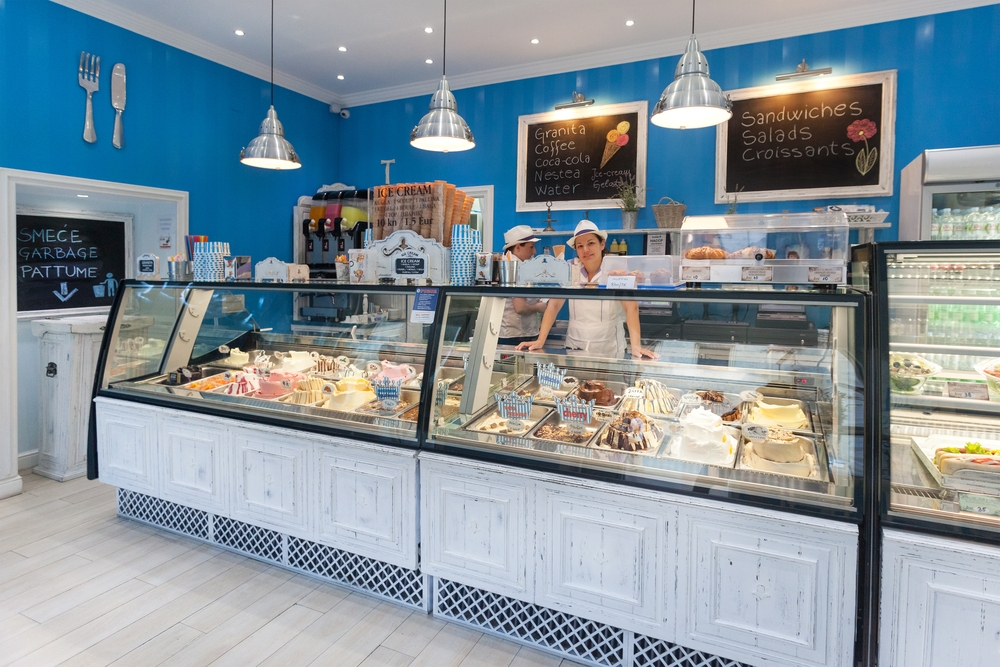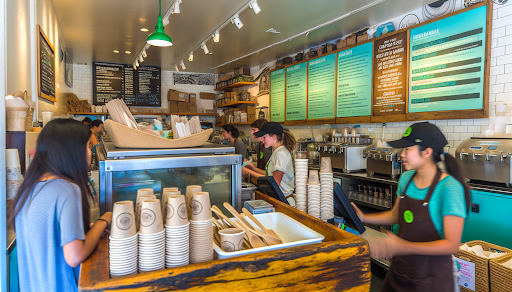Ice Cream Shop Failure Rates: Strategies for Success
By Hamza Benhlima · 13. February 2024
The ice cream shop failure rate is daunting: only 50% of these shops pass the five-year mark.
If you’re looking to enter the ice cream business, it’s critical to understand why they fail and how to succeed.
This article breaks down the statistics📊 and strategic measures needed to turn the odds in your favor and create a stable, profitable ice cream business.
Ice Cream Shop Survival Statistics
 ice cream hangout
ice cream hangout
It may come as a cold shock that nearly a fifth of ice cream shops fail to celebrate their first anniversary, succumbing to the fierce competition.
Fast-tracking to half a decade later, only 50% of these ventures remain operational, painting a somewhat icy picture of the ice cream industry.
However, these statistics aren’t meant to freeze your dreams.
Instead, they serve as a reminder that the journey of running an ice cream shop, like any small business, is a rocky road that requires a solid plan and a passion for ice cream.
The Reasons Behind Ice Cream Shop Shutdowns
The path from conceptualizing an ice cream shop to making it a flourishing ice cream business can be disrupted by a handful of recurrent challenges.
From mismanagement and underfunding to poor location choices, these factors often conspire to pull the plug on the ice cream dreams of many entrepreneurs, causing small businesses fail.
A well-crafted business plan can help mitigate these risks and set the foundation for a successful ice cream shop, paving the way for a thriving new business in the realm of other business ventures.
Mismanagement
Mismanagement can lead to the downfall of an ice cream shop.
The list of potential blunders is long, spanning from poor inventory control to relying solely on word-of-mouth marketing.
The owner/operator needs to possess a mix of skills, from a good manager to being detail-oriented to having excellent customer service skills.
Nonetheless, the path towards achieving a successful ice cream shop is frequently marred by classic errors.
Skipping through market research, offering the same old products, and underestimating the importance of location are just some of the mistakes that can lead to a meltdown.
To turn the tide, a winning combination of top-notch ice cream selection, savvy marketing, and smooth operations is needed.
Financial Freeze
The aspiration of owning an ice cream shop carries a financial commitment.
Depending on your vision, you could be looking at anything from $3,000 for a basic ice cream truck to $50,000 for a full-scale ice cream shop.
However, the harsh reality is that underinvesting can lead to a mediocre shop, devoid of growth prospects and burdened with substantial operating costs.
Underfunding an ice cream shop can make the business stale, potentially leading to missed opportunities and financial struggles.
To prevent a capital crunch, entrepreneurs often get creative with funding, ranging from crowdfunding to wooing private investors, all in the name of keeping the ice cream flowing.
Location, Location, Miscalculation
Choosing the right location is akin to finding the perfect ingredient for a masterful ice cream recipe.
It’s more than just a physical spot; it’s about being where your customers are and where they want to be.
The importance of location can’t be overstated, and skipping market research before choosing a location is like serving ice cream without a cone, a definite no-no.
The neighborhood demographics can make or break an ice cream shop.
The key to success🥇 is to connect with locals and cater to their cravings.
Ideal locations include places with a constant flow of people, like parks, schools, and shopping malls, perfect for drawing in a crowd of eager customers.
However, overlooking factors like retail competition, accessibility, and cost can lead an ice cream shop to a rocky road.
Navigating Through Seasonal Sales Fluctuations
In the realm of ice cream, maneuvering through seasonal sales swings is as critical as mastering the art of the creamiest scoop.
The rhythm of high and low seasons can pose a challenge, but with strategic planning, ice cream businesses can ride these waves effectively and maintain a thriving business.
Winter Woes: Keeping the Business Warm
As the temperature drops, so does the demand for ice cream, turning winter into a challenging season for ice cream businesses.
However, a little creativity can turn these chilling times into opportunities.
Introducing winter edition flavors can spark🌟 customer interest and heat up cold-season sales for ice cream shops.
Summer Surge: Preparing for Peak Season
Summer, the peak season for ice cream parlors, ushers in a flood of customers and an upswing in sales.
Preparing for this surge involves strategies like offering seasonal flavors, running promotions, and ensuring sufficient staff to handle increased demand.
These strategies not only help to maximize profits but also ensure a smooth service experience, preventing long wait times and customer dissatisfaction.
Crafting a Unique Selling Point for Your Ice Cream Store
 ice cream shop
ice cream shop
In the saturated ice cream marketplace, possessing a distinctive selling proposition (USP) can set your shop apart from rivals and draw in customers.
Your USP could be anything from a mind-blowing flavor, an out-of-this-world ingredient, or a commitment to sustainability.
To craft a potent USP, ice cream shop owners need to flex their strengths and conduct detailed research on their competition.
This insight can help them craft a concept that truly resonates with their audience and sets them apart from the rest.
A strong USP can grab attention, boost sales, and enhance the customer experience, making it a key ingredient for success.
The Cold Truth About Overhead Expenses
Operating an ice cream shop encompasses a range of overhead expenditures, including rent, utilities, and wage expenses.
Understanding these costs and managing them effectively is crucial for the profitability of an ice cream shop.
To calculate overhead costs, ice cream shop owners can use a formula that divides total overhead costs by total sales, expressed as a percentage.
Typically, ice cream shop owners allocate about 30-40% of their revenue to cover overhead costs.
However, if these costs are not managed efficiently, they can significantly impact the shop’s net profit margin.
Labor Pains: Managing Staff and Costs
 #image_title
#image_title
A well-managed team is crucial for the smooth operation of an ice cream shop.
From providing excellent customer service to ensuring efficient operations, employees play a vital role in the shop’s success.
However, labor costs can be a significant expense, with entry-level employees typically earning minimum wage.
To manage labor costs effectively, ice cream shop owners can use strategies like efficient shift scheduling and using on-call workers.
They can also use tools like scheduling software to streamline this process and ensure efficient staff utilization.
From Soft Serve to Hard Cash: Pricing Structures That Work
Pricing constitutes a vital element of all business strategies, including those of ice cream shops.
The cost of production, from ingredients to labor and packaging, plays a significant role in setting the prices for ice cream treats.
Variable costs, such as those associated with ingredients and labor, are particularly important to consider.
To maximize profitability, ice cream shops often aim for a markup of 200-300% on their products, targeting gross profit margins of 50% to 75%.
A well-crafted pricing strategy, combined with a keen understanding of the competition and market conditions, can help an ice cream shop outsmart the competition📈 and stay ahead in the market.
Understanding Net Profit Margins
Net profit margin serves as a significant parameter that ice cream shop proprietors must comprehend to make well-informed business decisions.
The average net profit margin for an ice cream shop can range from 5% to 25%, depending on various factors like location and competition.
However, the net profit margin can be influenced by several factors, including:
- the level of competition
- market saturation
- the ability to maintain a high gross profit margin
- the cost of goods sold (COGS)
High COGS can lower the gross profit margin, which in turn affects the net profit margin.
Marketing Meltdown: Avoiding Common Pitfalls
Marketing plays an indispensable role for ice cream shops in attracting customers and establishing a robust brand image.
However, common mistakes like blending in with the crowd, relying solely on word-of-mouth, and having a muddled strategy can lead to a marketing meltdown.
Effective marketing strategies include:
- Understanding the target audience
- Creating engaging social media content
- Offering incentives for customer engagement
- Constantly monitoring feedback
Pinpointing the target audience can provide insights into what customers really want, enabling the shop to customize its products and promotions accordingly.
Complying with Legal Requirements
Adherence to legal prerequisites is an essential aspect of operating an ice cream shop.
From obtaining the necessary business licenses to meeting local health and safety standards, these legal requirements ensure the smooth operation of the shop.
However, non-compliance can lead to serious consequences, including unlimited fines under new sentencing guidelines.
Therefore, it’s crucial for ice cream shop owners to stay updated with all the relevant regulations and ensure their business operations comply with them.
Building Loyalty and Demand
Cultivating a faithful customer base and stimulating product demand are vital for the sustained success🏆 of an ice cream shop.
One effective way to achieve this is through customer loyalty programs, which can reward customers for their purchases and lure in new ones with tempting offers.
These programs, along with a commitment to quality and service, can help an ice cream shop create a strong brand identity, build customer loyalty, and drive demand for its products.
Handling Inventory and Supply Chain
Efficient management of inventory and the supply chain is essential for the smooth operation of any ice cream shop.
Proper inventory management can help reduce waste, save money, and ensure product availability.
On the other hand, a well-managed supply chain can:
- Ensure the smooth delivery of products
- Maintain top-notch sanitation
- Use technology for efficiency
- Implement creative strategies to reduce waste and promote sustainability in operations.
Summary
In the icy world of ice cream shops, the journey from soft serve to hard cash is filled with sweet triumphs and frosty challenges.
From understanding survival statistics to navigating seasonal sales fluctuations, crafting a unique selling point, managing overhead expenses, and complying with legal requirements, it’s clear that behind every scoop of ice cream is a whole lot of strategy.
As we’ve seen in this journey, running a successful ice cream shop isn’t just about serving up delicious treats; it’s about blending passion with business acumen, creativity with practicality, and customer service with profitability.
Frequently Asked Questions
Is an ice cream business profitable?
Starting an ice cream business can be highly profitable, given the widespread popularity of this enticing treat. Just ensure you have a good grasp of the business before diving in.
How many customers does the average ice cream shop have a day?
It’s estimated that the average ice cream shop has about 300 customers per day, with visits mainly driven by children. So, it’s safe to say that it’s a popular spot for families looking for a sweet treat.
Is the ice cream business feasible?
Absolutely! With its widespread popularity, starting an ice cream business is a highly profitable and lucrative venture.
What are some common reasons for the failure of ice cream shops?
Many ice cream shops find themselves melting away due to pitfalls like mismanagement, insufficient funding, and less-than-ideal locations. Avoid letting your ice cream dream drip away by making smart, strategic business choices.

